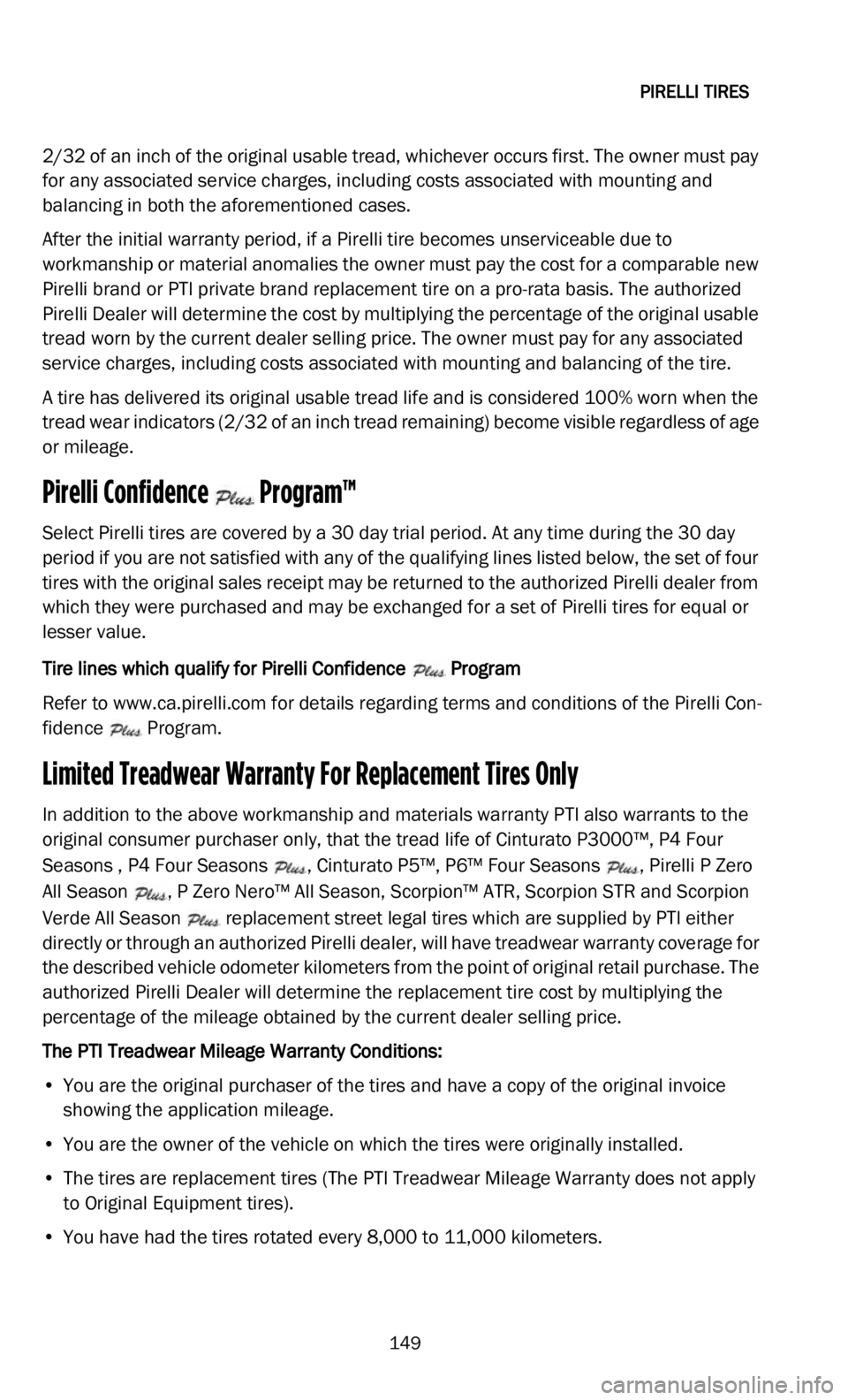change time DODGE DURANGO 2022 Vehicle Warranty
[x] Cancel search | Manufacturer: DODGE, Model Year: 2022, Model line: DURANGO, Model: DODGE DURANGO 2022Pages: 200, PDF Size: 6.72 MB
Page 31 of 200

BFGOODRICH® TIRES
30
REPLACEMENT OF TWO TIRES
It is recommended that all four tires are replaced at the same time. However, whenever
on
ly two tires are replaced, the new ones should be put on the rear. The new tires, with
deeper tread, may provide better grip and water evacuation in wet driving conditions.
CUSTOMIZATION OF TIRES, WHEELS, OR SUSPENSION ON SUVS AND LIGHT
TRUCKS
Due to their size, weight and higher center of gravity, vehicles such as SUVs and light
trucks do not
have the same handling characteristics as automobiles. Because of these
differing characteristics, failure to operate your SUV/truck in a proper and safe manner
can increase the likelihood of vehicle rollover. Modifications to your SUV/truck tire size,
tire type, wheels or suspension can change its handling characteristics and further
increase the likelihood of vehicle rollover. Whether your SUV/truck has the original
equipment configuration for tires, wheels and suspension or whether any of these items
have been modified, always drive safely, avoid sudden, sharp turns or lane changes and
obey all traffic laws. Failure to do so may result in loss of vehicle control leading to an
accident and serious injury or death.
TIRE ALTERATIONS
Do not make or allow to be made any alterations on your tires. Alterations may prevent
p r
oper performance, leading to tire damage which can result in an accident. Tires which
become unserviceable due to alterations such as trueing, whitewall inlays, addition of
balancing or sealant liquids, or the use of tire dressing containing petroleum distillates
are excluded from warranty coverage.
REPAIRS - WHEREVER POSSIBLE, SEE YOUR BFGOODRICH® TIRE RETAILER AT ONCE
If any BFGoodrich® tire sustains a puncture, have the tire demounted and thoroughly
i n
spected by any BFGoodrich® tire retailer for possible damage that may have occurred.
A tread area puncture in any BFGoodrich® passenger or light truck tire can be repaired
p r
ovided that the puncture hole is not more than 1/4 of an inch in diameter, not more
than one radial cable per casing ply is damaged, and the tire has not been damaged
further by the puncturing object or by running underinflated. Tire punctures consistent
with these guidelines can be repaired by following the Rubber Manufacturers Association
(RMA) recommended repair procedures.
TIRE REPAIRS
Repairs of all tires must be of the combined plug and inside patch type. Plug only repairs
are improper. A tire should be removed from the rim and inspected prior to repair. Any
tire repair done without removing the tire from the rim is improper. An improperly
repaired tire will cause further damage to the tire by either leaking air or allowing air,
moisture and contaminants to enter the structure of the tire. An improperly repaired tire
can fail suddenly at a later date.
Never repair a tire with less than 2/32 of an inch tread remaining. At this tread depth,
t h
e tire is worn out and must be replaced.
Page 33 of 200

BFGOODRICH® TIRES
32
FOLLOW THESE MOUNTING RECOMMENDATIONS
Tire changing can be dangerous and must be done by professionally trained persons
us
ing proper tools and procedures as specified by the Rubber Manufacturers
Association (RMA).
Your tires should be mounted on wheels of correct size and type and which are in good,
c le
an condition. Wheels that are bent, chipped, rusted (steel wheels) or corroded (alloy
wheels) may cause tire damage. The inside of the tire must be free from foreign material.
Have your retailer check the wheels before mounting new tires. Mismatched tires and
rims can explode during mounting. Also, mismatched tires and rims can result in
dangerous tire failure on the road. If a tire is mounted by error on the wrong-sized rim, do
not remount it on the proper rim — scrap it. It may have been damaged internally (which
is not externally visible) by having been dangerously stretched and could fail on the
highway.
Old valves may leak. When new tubeless tires are mounted, have new valves of the
c o
rrect type installed. Tubeless tires must only be mounted on wheels designed for
tubeless tires i.e., wheels which have safety humps or ledges.
It is recommended that you have your tires and wheels balanced. Tires and wheels which
a r
e not balanced may cause steering difficulties, a bumpy ride, and irregular tire wear.
Be sure that all your valves have suitable valve caps. The valve cap is the primary seal
a g
ainst air loss.
SERVICE LIFE FOR PASSENGER CAR AND LIGHT TRUCK TIRES INCLUDING SPARE
TIRES
The following recommendation applies to passenger car and light truck tires. Tires are
composed of various types of material and rubber compounds, having performance
properties essential to the proper functioning of the tire itself. These component
properties evolve over time. For each tire, this evolution depends upon many factors
such as weather, storage conditions, and conditions of use including load, speed,
inflation pressure, maintenance etc. to which the tire is subjected throughout its life. This
service-related evolution varies widely so that accurately predicting the serviceable life
of any specific tire in advance is not possible.
In addition to regular inspections and inflation pressure maintenance by consumers, it is
re
commended to have passenger car and light truck tires, including spare tires,
inspected regularly by a qualified tire specialist, such as a tire dealer, who will assess the
tire’s suitability for continued service. Tires which have been in use for five years or more
should continue to be inspected by a specialist at least annually.
Consumers are strongly encouraged to be aware not only of their tires’ visual condition
an
d inflation pressure but also of any change in dynamic performance such as increased
air loss, noise or vibration, which could be an indication that the tires need to be removed
from service to prevent tire failure.
Page 44 of 200

BRIDGESTONE® - FIRESTONE®
43
• Never exceed the Gross Vehicle Weight Rating (GVWR) or front/rear Gross Axle Weight Rating (GAWR) of your vehicle.
• C onsult your vehicle Owner’s Manual for load recommendations and special instruc -
t
ions such as for trailer/towing and snow plow installations.
TIRE DAMAGE, INSPECTION AND SERVICE LIFE
Evaluation and maintenance of your tires is important to their performance and the
service they provide to you. Over time and/or through use, the condition of a tire can
change from exposure to everyday road conditions, the environment, damaging events
such as punctures, and other external factors.
You should visually inspect your tires on a regular basis throughout their life, and you
sh
ould have your tires periodically evaluated by a qualified tire service professional when
your vehicle is serviced such as routine maintenance intervals, oil changes, and tire
rotations. In particular, note the following tips for spotting tire damage:
• A fter striking anything unusual in the roadway, have a qualified tire service profes -
s
ional demount the tire and inspect it for damage. A tire may not have visible signs of
d a
mage on the tire surface. Yet, the tire may suddenly fail without warning, a day, a
week, or even months later.
• I nspect your tires for cuts, cracks, splits or bruises in the tread and sidewall areas.
B
umps or bulges may indicate a separation within the tire body. Have your tire
inspected by a qualified tire service professional. It may be necessary to have it
removed from the wheel for a complete inspection.
• I nspect your tires for adequate tread depth. When the tire is worn to the built-in indi -
c
ators at 2/32 of an inch (1.6 mm) or less tread groove depth, or the tire cord or fabric
i s
exposed, the tire is dangerously worn and must be replaced immediately.
• I nspect your tires for uneven wear. Wear on one side of the tread or flat spots in the
t
read may indicate a problem with the tire or vehicle. Consult a qualified tire service
professional.
• I nspect your wheels also. If you have a bent or cracked wheel, it must be replaced.
•
Don’t forget to check the spare tire.
M
ake sure your tires, including the spare tire, continue to be regularly inspected after 5
y e
ars of service to determine if they can continue in service. Even when your tires appear
to be usable from their external appearance or the tread depth may have not reached
the minimum wear out depth, it is recommended that all tires (including spare tires and
“temporary use” spares) more than 10 years old be replaced with new tires.
WARNING!
Driving on damaged tires is dangerous. A damaged tire can suddenly fail causing
serious personal injury or death. Have your tires regularly inspected by a qualified tire
service professional.
Page 102 of 200

GOODYEAR® DUNLOP® TIRES
101
TIRE SERVICE LIFE
Tires are designed and built to provide many thousands of miles/kilometers of excellent
service. For maximum benefit, tires must be maintained properly to avoid tire damage
that may result in removal from service before the tread is worn down to minimum depth.
It is not practical to accurately predict the service life of any specific tire in chronological
t i
me since service conditions vary widely. The serviceability of a tire over time is a
function of the storage and service conditions (inflation pressure, load, speed, road
hazard injury, etc.) to which a tire is subjected. Consumers should not rely solely on the
appearance of the tire, but should be aware of any change in dynamic performance such
as increased air loss, noise or vibration, which could be a sign to remove the tire.
Therefore, it is essential to have tires, including spares, inspected regularly (at least
monthly) for proper inflation pressure, damage and treadwear.
Check your vehicle’s Owner’s Manual (or your vehicle) to determine if it is equipped with
r u
n-flat (extended mobility) tires. If your vehicle is equipped with run-flat tires, the
following applies:
RUN-FLAT TECHNOLOGY EXTENDED MOBILITY TECHNOLOGY (EMT™), RUNONFLAT®
( R
OF) AND DUNLOP® SELF-SUPPORTING TECHNOLOGY (DSST®) ORIGINAL EQUIPMENT
TIRES
IMPORTANT SAFETY INFORMATION
OPERATIONAL MONITORING
The information contained in this Limited Warranty Brochure applies only to the Original
E q
uipment tires supplied with your vehicle. In order for Goodyear® Run-Flat (Extended
Mobility Technology [EMT], RunOnFlat [ROF]) or Dunlop® Run-Flat (Dunlop® Self-
Supporting Technology [DSST]) tires to obtain the performance criteria stated within this
Limited Warranty, Goodyear® or Dunlop® Run-Flat tires must use specific parts, such as
a low tire pressure monitoring system authorized by the Original Equipment vehicle
manufacturer.
RUN-FLAT TIRE FEATURE:
The Goodyear® or Dunlop® Run-Flat tire is a high-performance tire with a remarkable
f e
ature: It can operate for limited distances with very low or even no inflation pressure
(refer to your Vehicle Owner’s Manual for these limitations). This is an important benefit,
especially if inflation loss occurs at a location where immediately stopping your vehicle
could be hazardous.
TIRE PRESSURE MONITORING SYSTEM ALERT:
Refer to your vehicle Owner’s Manual for more information on what to do if the tire
p r
essure warning system activates.
Page 112 of 200

KUMHO TIRES
111
4. The cost of applicable taxes and mounting and balancing and any other service charges.
5. T ire damage or irregular wear due to:
•
Road hazard, including puncture, cut, impact break, bulge, snag, stone drill, colli -
s
ion.
• C ontinued use while run flat or under acute underinflation.
•
Improper use or operation, without limitation, improper inflation pressure, over -
l
oading, use of an improper rim, tire/wheel assembly imbalance or other vehicle
c o
ndition, worn suspension components, improper mounting or de-mounting,
misuse, misapplication, fire or other externally generated heat, water or other
material trapped inside the tire during mounting, tire alteration, racing or compe -
tition purposes, improper inserting of sealant, balance or filler materials.
• Improper repair, or with repairs not conforming to the Rubber Manufacturers Asso -
c
iation standards, or with section repairs, or with self-vulcanizing plug only.
• F ailure to rotate the tire at least every 5,000 m
iles (8,047 km) as evidenced by
Ku
mho’s Mileage Warranty/Tire Rotation Card (printed in this brochure) or vehicle
misalignment.
• U neven or rapid wear which is caused by mechanical irregularity in the vehicle
s
uch as misalignment, (a measured tread difference of 2/32 of an inch or more
across the tread on the same tire).
6. O zone or weather cracking on tires over four (4) years from the date of manufacture.
7
. T ires that have been recapped, or retreaded, regrooved.
8
. R ide disturbance (out-of-round, vibration, pulling, etc.) claims submitted after the first
2
/32 of an inch of tread wear.
9. Lo ss of time, or use, inconvenience, or any incidental or consequential damage.
1
0.T ires that have been modified by the addition or removal of material or any tire inten -
t
ionally altered to change its appearance.
11.T ires unserviceability caused by the tire operation in excess of tire/wheel manufac -
t
urers specifications and recommendations.
12.T ires that are misapplied due to insufficient speed rating, or undersized, or oversized
t
ires.
13.T ires that have become unserviceable because chemical corrosion, vandalism,
c
hains and flat spotting.
14.T ires involved in any racing-related activities.
1
5.T his limited warranty applies only to the original purchaser and is nontransferable.
Page 117 of 200

KUMHO TIRES
116
4. Radial truck tires used in mining service are not eligible under this program.
VI. REPLACEMENT WARRANTY
If you receive a replacement tire under this warranty, it will be covered by the
manufacturer’s warranty and the supplemental limited mileage warranty that Kumho
Tire USA, Inc. gives on that tire.
THIS IS THE ONLY EXPRESS WARRANTY GIVEN BY KUMHO APPLICABLE TO KUMHO/
MA
RSHAL REPLACEMENT TIRES. KUMHO DOES NOT MAKE ANY OTHER EXPRESS
WARRANTY OR IMPLIED WARRANTY OF MERCHANT ABILITY OR FITNESS FOR A
PARTICULAR PURPOSE.
KUMHO DOES NOT AUTHORIZE ANY OTHER PERSONS, INCLUDING AUTHORIZED
D E
ALERS TO CHANGE THIS WARRANTY OR CREATE ANY OTHER OBLIGATION IN
CONNECTION WITH KUMHO/MARSHAL TIRES. KUMHO WILL NOT DO ANYTHING OTHER
THAN WHAT IS STATED IN THIS WARRANTY IF A DEFECT IS FOUND TO EXIST IN A KUMHO/
MARSHAL REPLACEMENT RADIAL TIRE. ALL OTHER REMEDIES ARE EXCLUDED,
INCLUDING ANY OBLIGATION OR LIABILITY ON THE PART OF KUMHO FOR
CONSEQUENTIAL OR INCIDENTAL DAMAGES (SUCH AS LOSS OF USE OF CAR, LOSS OF
TIME OR INCONVENIENCE) ARISING OUT OF A DEFECT.
THE REMEDIES SET FORTH IN THIS LIMITED WARRANTY ARE THE SOLE AND EXCLUSIVE
R E
MEDIES FOR BREACH OF WARRANTY. SOME STATES DO NOT ALLOW THE EXCLUSION
OR LIMITATION OF INCIDENTAL OR CONSEQUENTIAL DAMAGES, SO THE ABOVE Tire Size
Casing Value
8.25R15, 7.50R16, 8R17.5 $30.00
215/75R17.5, 235/75R17.5 $30.00
225/70R19.5, 245/70R19.5 $30.00
265/70R19.5, 285/70R19.5 $30.00
8.25R16 $35.00
255/70R22.5 $50.00
9.00R20, 10R22.5 $60.00
10.00R20, 295/80R22.5 $80.00
11.00R20, 12.00R20 $90.00
10.00R22, 11.00R22, 12.00R24 $90.00
11R22.5, 295/75R22.5 $95.00
11R24.5, 285/75R24.5 $95.00
12R22.5, 315/80R22.5 $100.00
385/65R22.5, 425/65R22.5, 44
5/65R22.5 $100.00
Page 134 of 200

MICHELIN®
133
Full-size Spare
Full-size spare tires (not temporary spares) of the same size and construction should be
u s
ed in a five tire rotation. Always check the inflation pressure of the full-size spare
immediately before incorporating it into rotation. Follow the vehicle manufacturer’s
recommended pattern for rotation, or if not available, see a qualified tire technician.
Replacement of Two Tires
It is recommended that all four tires are replaced at the same time. However, when only
t w
o tires are replaced, the new tires should be put on the rear. The new tires, with deeper
tread, may provide better grip and water evacuation in wet driving conditions.
CUSTOMIZATION OF TIRES, WHEELS, OR SUSPENSION ON SUVS AND LIGHT
TRUCKS
Due to their size, weight and higher center of gravity, vehicles such as SUVs and light
trucks do not have the same handling characteristics as automobiles. Because of these
differing characteristics, failure to operate your SUV/truck in a proper and safe manner
can increase the likelihood of vehicle rollover. Modifications to your SUV/truck tire size,
tire type, wheels or suspension can change its handling characteristics and further
increase the likelihood of vehicle rollover. Whether your SUV/truck has the original
equipment configuration for tires, wheels and suspension or whether any of these items
have been modified, always drive safely, avoid sudden, sharp turns or lane changes and
obey all traffic laws. Failure to do so may result in loss of vehicle control leading to an
accident and serious injury or death.
TIRE ALTERATIONS
Do not make or allow to be made any alterations on your tires. Alterations may prevent
proper performance, leading to tire damage which can result in an accident. Tires which
become unserviceable due to alterations such as truing, whitewall inlays, addition of
balancing or sealant liquids, or the use of tire dressing containing petroleum distillates
are excluded from warranty coverage.
REPAIRS WHEREVER POSSIBLE, SEE YOUR MICHELIN® TIRE RETAILER AT ONCE
If any MICHELIN® tire sustains a puncture, have the tire demounted and thoroughly
inspected by any MICHELIN® tire retailer for possible damage that may have occurred.
A tread area puncture in any MICHELIN® passenger or light truck tire can be repaired
provided that the puncture hole is not more than 1/4 inch in diameter, not more than
o n
e radial cable per casing ply is damaged, and the tire has not been damaged further
by the puncturing object or by running underinflated. Tire punctures consistent with
these guidelines can be repaired by following the US Tire Manufacturers Association
(USTMA) recommended repair procedures.
TIRE REPAIRS
Repairs of all tires must be of the combined plug and inside patch type. Your MICHELIN®
PAX® System tires must be removed from the wheel for inspection prior to repair. Plug
only repairs are improper. A tire should be removed from the rim and inspected prior to
Page 137 of 200

MICHELIN®
136
TEMPORARY TYPE SPARE TIRES
When using any temporary type spare tire, be sure to follow the vehicle manufacturer’s
in
structions.
READING THE DOT
DOT XXXX XXXX XXX (prior to August 2000)
DOT XXXX XXXX XXX (1990-1999)
DOT XXXX XXXX XXXX (after July 2000)
THE DOT
The “DOT” symbol certifies tire manufacturer’s compliance with US Department of
Transportation tire safety standards. Next to the symbol is the tire identification or “serial
number”. The first two characters identify the plant where the tire was manufactured.
The next two characters reflect the tire size. The following one to four digits may be used
at the tire manufacturer’s option as a descriptive code. The last three characters are
numbers identifying the week and year of manufacture. (Example: “O25” means second
week of the year of decade, eg.: 1995, 1985, etc.) For the 1990-1999 decade
MICHELIN® brand tires are marked with a triangle pointing to the last three numeric
characters. Tires produced after July 2000 have an additional digit to identify a given
decade. For example, 2800 means the tire was produced during the 28th week of 2000;
0 2
01 during the 2nd week of 2001. If the last digits of your DOT number contains three
numeric characters and is not marked with a triangle, consult a qualified tire technician
to determine the year of manufacture.
SERVICE LIFE FOR PASSENGER CAR AND LIGHT TRUCK TIRES INCLUDING SPARE
TIRES
The following recommendation applies to passenger car and light truck tires. Tires are
composed of various types of material and rubber compounds, having performance
properties essential to the proper functioning of the tire itself. These component
properties evolve over time. For each tire, this evolution depends upon many factors
such as weather, storage conditions, and conditions of use (load, speed, inflation
pressure, maintenance etc.) to which the tire is subjected throughout its life. This
service-related evolution varies widely so that accurately predicting the serviceable life
of any specific tire in advance is not possible.
That is why, in addition to regular inspections and inflation pressure maintenance by
c o
nsumers, it is recommended to have passenger car and light truck tires, including
spare tires, inspected regularly by a qualified tire specialist, such as a tire dealer, who
will assess the tire’s suitability for continued service. Tires which have been in use for five
years or more should continue to be inspected by a specialist at least annually.
Consumers are strongly encouraged to be aware not only of their tires’ visual condition
and inflation pressure but also of any change in dynamic performance such as increased
air loss, noise or vibration, which could be an indication that the tires need to be removed
from service to prevent tire failure. It is impossible to predict when tires should be
Page 144 of 200

NEXEN TIRE
143
as measured from shoulder to shoulder on the claim tire, and compared to the
remaining tread depth of the opposite front/rear or left/right tire.
• C omplete and sign the Nexen Tire Claim Adjustment form provided by the dealer, keep
a
copy for your records and leave the tire with the dealer for warranty processing.
ROADSIDE ASSISTANCE
Patterns sold after May 1, 2014 by Nexen Tire in the United States and Canada are
eligible for a free 24/7/365 Roadside Assistance for a period of 36 months from the
p u
rchase date. Upon purchasing Nexen Tires, the consumer will receive an activation
card from the tire shop. An online registration needs to be completed in order to have
access to a toll free phone number to call in case of a flat tire. A qualified professional
will change your flat tire with your spare tire free of charge. If a working spare is not
available, towing will be provided free of charge to the nearest Nexen Tire dealer or
authorized place of repair.
*Nexen Tire reserves the right to change the terms and conditions of all warranties at
a n
y time.
TIRE CARE AND MAINTENANCE GUIDE
Tire failure can result in serious damage and/or personal injury. To reduce the risk of tire
failure we recommend the following:
• M aintain proper inflation pressure and do not use at underinflation or overinflation.
P
ressure should be set at the level recommended by vehicle manufacturer.
• W heel alignment and balancing should be checked at regular intervals.
•
Do not overload. The maximum load carrying capacity is molded on the sidewall of the
t
ire.
• D o not spin your tires excessively and avoid driving over curbs, potholes, obstacles
a
nd edges of pavement.
• N ever drive on smooth (bald) tires. By law, tires must be replaced when 2/32 of an
i
nch of tread depth remained, as indicated by tread wear indicator molded in the tread
grooves.
• C heck your tires frequently for any scrapes, cuts, foreign objects, separations or
b
ulges. If damage is found, do not attempt to dismount a tire yourself. Change
damaged tire with the spare and contact a local authorized Nexen Tire dealer imme -
diately.
• D o not drive in excess of speed limits allowed by law or the maximum speed justified
b
y driving conditions.
• T o achieve proper even wear and gain maximum tread life, tire rotation at regular
i
ntervals is required.
Page 150 of 200

PIRELLI TIRES
149
2/32 of an inch of the original usable tread, whichever occurs first. The owner must pay
for any associated service charges, including costs associated with mounting and
balancing in both the aforementioned cases.
After the initial warranty period, if a Pirelli tire becomes unserviceable due to
w o
rkmanship or material anomalies the owner must pay the cost for a comparable new
Pirelli brand or PTI private brand replacement tire on a pro-rata basis. The authorized
Pirelli Dealer will determine the cost by multiplying the percentage of the original usable
tread worn by the current dealer selling price. The owner must pay for any associated
service charges, including costs associated with mounting and balancing of the tire.
A tire has delivered its original usable tread life and is considered 100% worn when the
t r
ead wear indicators (2/32 of an inch tread remaining) become visible regardless of age
or mileage.
Pirelli Confidence Program™
Select Pirelli tires are covered by a 30 day trial period. At any time during the 30 day
period if you are not satisfied with any of the qualifying lines listed below, the set of four
tires with the original sales receipt may be returned to the authorized Pirelli dealer from
which they were purchased and may be exchanged for a set of Pirelli tires for equal or
lesser value.
Tire lines which qualify for Pirelli Confidence
Program
Refer to www.ca.pirelli.com for details regarding terms and conditions of the Pirelli Con -
fidence Program.
Limited Treadwear Warranty For Replacement Tires Only
In addition to the above workmanship and materials warranty PTI also warrants to the
original consumer purchaser only, that the tread life of Cinturato P3000™, P4 Four
Seasons , P4 Four Seasons
, Cinturato P5™, P6™ Four Seasons , Pirelli P Zero
All Season , P Zero Nero™ All Season, Scorpion™ ATR, Scorpion STR and Scorpion
Verde All Season replacement street legal tires which are supplied by PTI either
directly or through an authorized Pirelli dealer, will have treadwear warranty coverage for
t h
e described vehicle odometer kilometers from the point of original retail purchase. The
authorized Pirelli Dealer will determine the replacement tire cost by multiplying the
percentage of the mileage obtained by the current dealer selling price.
The PTI Treadwear Mileage Warranty Conditions:
• Y ou are the original purchaser of the tires and have a copy of the original invoice
s
howing the application mileage.
• Y ou are the owner of the vehicle on which the tires were originally installed.
•
The tires are replacement tires (The PTI Treadwear Mileage Warranty does not apply
t
o Original Equipment tires).
• Y ou have had the tires rotated every 8,000 to 11,000 kilometers.